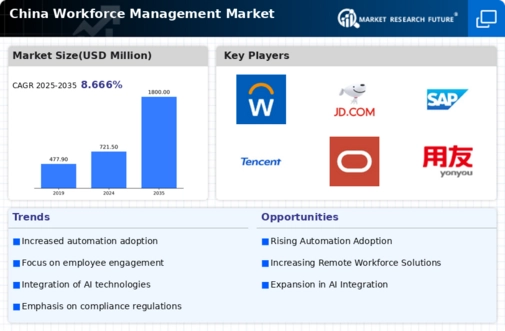Evolving Labor Market Dynamics
The workforce management market in China is significantly influenced by evolving labor market dynamics. With a growing emphasis on flexible work arrangements and remote working options, companies are adapting their workforce management strategies to accommodate these changes. Recent data indicates that approximately 40% of employees in urban areas prefer hybrid work models, prompting organizations to rethink their workforce management approaches. This shift necessitates the implementation of advanced scheduling and communication tools to ensure seamless collaboration among remote and on-site employees. Furthermore, the increasing participation of millennials and Gen Z in the workforce is driving demand for more agile and responsive workforce management solutions. As a result, businesses are compelled to invest in technologies that support diverse work environments, thereby enhancing employee satisfaction and retention rates.
Focus on Data-Driven Decision Making
In the current landscape, the workforce management market in China is increasingly leaning towards data-driven decision making. Organizations are recognizing the value of leveraging data analytics to optimize workforce performance and enhance operational efficiency. By utilizing advanced analytics tools, companies can gain insights into employee productivity, attendance patterns, and resource allocation. This trend is underscored by the fact that organizations employing data analytics in their workforce management strategies report a 25% improvement in operational efficiency. As businesses strive to remain competitive, the integration of data analytics into workforce management systems is becoming essential. This shift not only aids in informed decision-making but also fosters a culture of continuous improvement, ultimately benefiting both employers and employees.
Rising Demand for Compliance Solutions
The workforce management market in China is witnessing a rising demand for compliance solutions as regulatory frameworks become increasingly complex. Organizations are required to adhere to various labor laws and regulations, which necessitates the implementation of robust compliance management systems. Recent statistics indicate that non-compliance can result in fines exceeding $100,000 for businesses, highlighting the financial implications of inadequate compliance measures. Consequently, companies are investing in workforce management solutions that incorporate compliance tracking and reporting features. This trend is particularly pronounced in industries such as finance and healthcare, where regulatory scrutiny is heightened. By prioritizing compliance, organizations not only mitigate risks but also enhance their reputation and trustworthiness in the market.
Technological Advancements in Automation
The workforce management market in China is experiencing a notable shift due to rapid technological advancements in automation. Automation technologies, such as robotic process automation (RPA) and artificial intelligence (AI), are being integrated into workforce management systems to enhance efficiency and reduce operational costs. As of 2025, it is estimated that automation could lead to a 30% increase in productivity across various sectors. This trend is particularly relevant in manufacturing and logistics, where labor-intensive processes are being streamlined. Consequently, organizations are increasingly investing in automated solutions to optimize workforce allocation and improve overall performance. The workforce management market is thus likely to see a surge in demand for automated tools that facilitate real-time data analysis and decision-making, ultimately transforming how businesses manage their human resources.
Emphasis on Employee Training and Development
The workforce management market in China is increasingly emphasizing employee training and development as a key driver of organizational success. Companies are recognizing that investing in employee skills and competencies is essential for maintaining a competitive edge. Recent surveys indicate that organizations that prioritize training see a 20% increase in employee engagement and productivity. As a result, businesses are allocating resources towards comprehensive training programs and workforce management solutions that facilitate continuous learning. This trend is particularly relevant in sectors experiencing rapid technological changes, where upskilling is crucial. By fostering a culture of learning, organizations not only enhance workforce capabilities but also improve retention rates, as employees are more likely to remain with companies that invest in their professional growth.























Leave a Comment